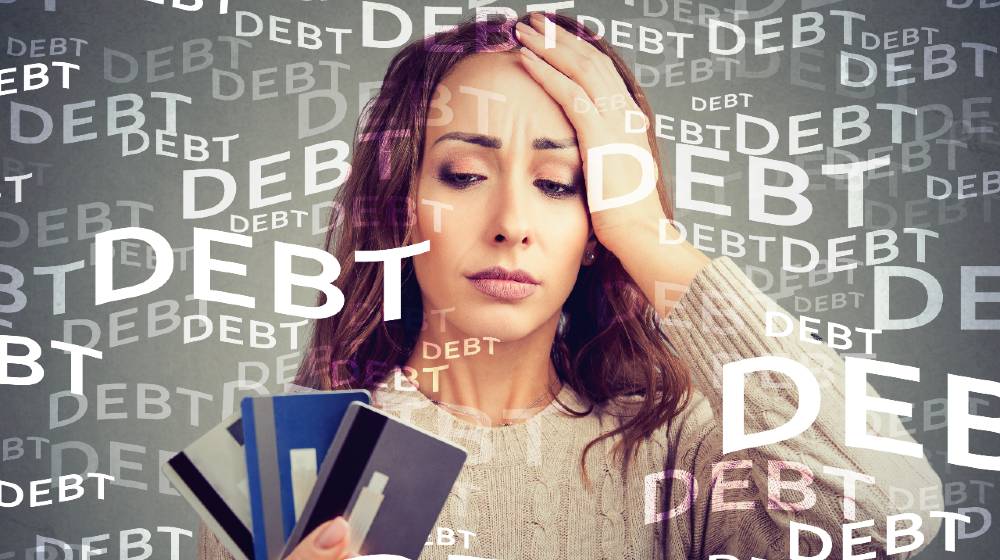If you have high credit card balances in 2018, you need to prioritize paying them off and doing so in the quickest possible time frame. The reason why is because credit card debt is now more expensive than it's ever been in the past, and if that's not enough reason, here are a few more statistics to fuel your desire to get out of debt.
RELATED: 3 Steps to Paying Off Debt
How to Quickly Crush Credit Card Debt (6 Best Ways)
- Total revolving debt in the United States as of February 2018, which is primarily made up of credit card debt, has reached $1.030 trillion, according to the latest Federal Reserve statistics. This is an all-time high for our country.
- Interest rates have increased twice already in 2018, and the CME FedWatch Tool suggests another rate hike is coming by the end of this month.
You're about to learn the six best ways to pay off high credit card debt, but before we dive in, first let's look at the most expensive option that you want to avoid.
The Most Expensive Credit Card Relief Option
The most expensive credit card relief option is when only paying minimum monthly payments. Never only minimum monthly payments on credit cards because you'll end up paying the maximum amount in interest.
For example, if you have a Chase credit card balance of $15,000 and your interest rate is 29%, when paying only minimum payments – you'll end up paying a total of $45,408 in interest alone and it would take you over ten years to pay off the balance.
1. Debt Snowball Method
The debt snowball method of paying off your credit card balances was proven to be the most effective credit card debt relief option in 2018, according to new research published by the Harvard Business Review.
With the debt snowball method, you pay off the credit card with the lowest balance first. Instantaneously after that initial credit card balance gets paid in full, your available monthly cash flow will increase.
You will then use the extra funds to put towards paying off the next smallest account. Once the second smallest account is paid in full, your available cash flow will increase even more and continue to grow, just like when rolling a snowball. Next, use all that extra money to pay off the third smallest account.
This method works by using psychological principles. When a person accomplishes a goal, like paying off that first credit card debt-the brain releases dopamine, and it feels good. And you want more of that good feeling, so you're motivated to continue paying off each debt one by one. Before you know it, you'll start to see the light at the end of the tunnel and your momentum will be at its peak, and at that point – nothing's going to stop you!
2. Debt Avalanche Method
The debt avalanche method focuses on attacking the account that's costing you the most money, which is the account with the highest interest rate. If you like math and numbers, you'll most likely lean towards this route, as it makes the most sense from a technical standpoint.
Technically speaking, this route will save you more money than the debt snowball method, if you can successfully stick to the plan.
There's lots of controversy surrounding the argument of which route is more effective, the debt snowball or avalanche method. Understand both options and then based on your personality type, you can determine which route is best for your situation.
Some people may decide to use a combination of these two options. You could start off with the debt snowball method, quickly knocking off your smaller debts that have a balance of $1,000 or less, and then switch to the debt avalanche method to pay off the remainder of your balances but in the most cost-efficient manner.
3. Balance Transfer Cards
You can slash your interest rates on credit cards, by using a balance transfer card that has no interest for 12-18 months. If you can pay your balance in full on the balance transfer card during the introduction period when the interest rate is zero, you'll end up eliminating 100% of your interest and only having to pay the balance transfer card's up-front fee.
Make sure to keep your credit cards open after paying them off because when closing a credit card your credit scores go down.
There are upfront fees that come with these cards, that range from 3%-5% of the balance.
Shop around for a balance transfer card that comes with:
- low up-front fees
- an 18-month introductory rate
- a zero percent interest rate
4. Home Equity Line of Credit
A home equity line of credit can be used to pay off high-interest credit card debt, saving you thousands of dollars in interest. Home equity lines of credit come with lower interest rates than any other type of bank loan. BankRate.com estimates that the average interest rate on a home equity line of credit is only 5%.
The downside is that you're switching your unsecured debt to secured debt, and this can be dangerous because if for some reason you default on payments, you could lose your property over a credit card debt.
5. Get Your Creditor to Reduce the Interest Rate
Don't overlook this next method, due to how simple it is. Sometimes, the simple things in life are most overlooked.
Call up your creditor and ask for a supervisor. Remind them of how many years you've been their client and how perfect your payment history has been over these years. Now express to them that you're upset that they're charging you such a high interest rate, and illustrate an offer that another bank is giving you. If your credit score had increased from what it was when you first applied for that credit card, also mention that.
Do some research and find a credit card company that's offering a lower rate, and you can then use them as leverage.
Example: “Capital One is offering me a credit card with an 8% interest rate and 1% more than what you're offering in cash-back. Could you please reduce my interest rate so that I can stay with your bank? Also, you'll notice my credit score had increased from what it was when I first applied for a card with your bank two years ago.”
6. Debt Relief Programs
A consumer credit counseling program can reduce your interest rates and get you out of debt in under five years, without hurting your credit score.
All your credit card debts will be combined into one consolidated monthly payment and the consumer credit counseling company then disperses the funds every month to your creditors but at the reduced interest rate. This program has the least effect on credit scores, compared to any other debt relief program.
A debt settlement program should only be used if you fell behind on credit card payments and can't afford to pay more than minimum monthly payments.
The reason why is because this type of program can drastically reduce your credit score and lead to negative notations across your credit report. However, if your credit score is already in the pits, then at this point you only need to focus on getting out of debt in the quickest possible time frame and avoiding bankruptcy. Once you become debt-free, you can then rebuild your credit score.
If you're on the urge of bankruptcy, debt settlement can be a viable alternative that gets you out of debt in around three years and gives you one affordable monthly payment for all your unsecured debts.
Need more options to get rid of high credit card balances? Check out this article next.






